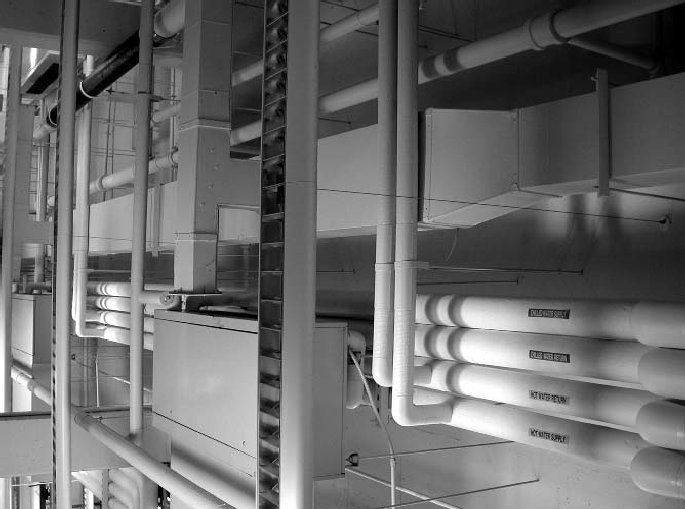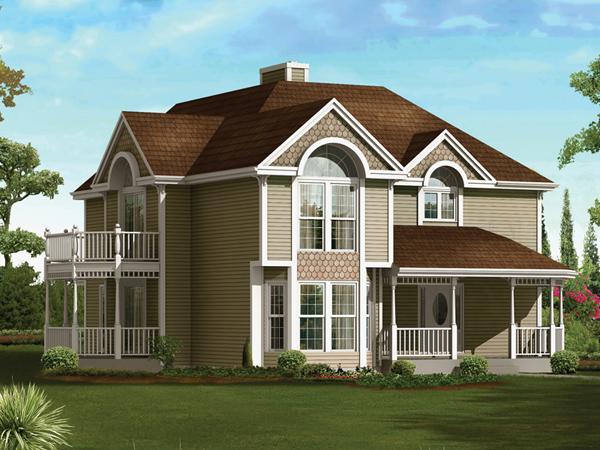
- •Intelligent houses
- •Preindustrial interiors: structure and space
- •Fig. 1. The Skeleton of a Simple Building
- •Machine-age interiors: dominance of mechanical and electrical systems
- •Fig. 2. Mechanical and Electrical Networks
- •Fig. 3. A two-storey house
- •Text c
- •1. A wall
- •Fig. 4. Smart Pot
- •Video Monitor
- •Smart Air Conditioner
- •Intelligent houses
- •Fig. 5. Buildings of the 21st century are acquiring electronic nervous systems
- •Fig. 6. Intelligent Systems
- •Unit 5 building materials
- •In our everyday lives, but define the environment in which we live.
- •Materias for construction
- •Text d bricks
- •Steel and other metals
- •Text g glass
- •In your group discuss what materials you would choose and why. Then present it to others, explaining your decision.
Machine-age interiors: dominance of mechanical and electrical systems
Now contrast this simple building with a typical twentieth-century suburban home. The most obvious difference is that the more modern interior is subdivided into numerous specialized rooms for particular purposes - typically several bedrooms for different family members, a living room, a dining room, a kitchen, bathrooms, and a garage. The most fundamental task is to configure these rooms well - that is, to get their sizes, proportions, interrelationships, and orientations right.
Each of these rooms requires specialized furniture and machinery to support the associated functions. So the second important task is to select the necessary items. There is bedroom, living room, and dining room furniture, and there are kitchen, bathroom, and entertainment fixtures and appliances. Natural light from the windows is supported by different electric light fixtures. And there are heating and mechanical ventilation fixtures to provide active means of climate control.
Also,
there are hot and cold water supplies to the kitchen and bathroom.
Thus, the plumbing plan is an important part of the project. There
may be gas supply, as well. And there is electrical wiring
everywhere. This requires another sheet of construction drawings.
All these systems require control devices, so it is necessary to
select, specify and locate these. They consist mostly of faucets and
valves for the plumbing, switches and dimmers for the electrical
system. Perhaps there are some additional automatic controls -
thermostats for the air conditioning and timers for the lights.
Fig. 2. Mechanical and Electrical Networks
Finally, the internal networks of the house are connected to large-scale utility networks. There are connections to water, gas, and electrical supply networks. The garage would be no use without the connection to a street system. Unlike the primitive house described earlier, which was autonomous in its operation, a modern house is greatly dependent on its utility connections.
Other modern building types - offices, factories, warehouses, schools, hospitals, laboratories, and so on - can be analyzed in similar ways. They consist of specialized interior spaces, with furniture and equipment adapted to the particular functions of those spaces. These spaces are tied together by internal mechanical and electrical networks, and these networks are linked to large-scale utilities.
Exercise 12. Is it True or False?
1. The main task is to get the sizes of the rooms, their proportions, interrelationships, and orientations right.
2. The second important task is to select furniture, fixtures and appliances.
3. It is not necessary to support natural light from the windows by electric light.
4. There are hot and cold water supplies to the bedroom and bathroom.
5. Gas supply should be in all houses.
6. Switches and dimmers are control devices for the electrical system.
7. The garage should be connected to a street system.
8. Factories and warehouses are not linked to large-scale utilities.
Exercise 13. What is the best heading for each paragraph?
§ 1…………………..
§ 2…………………..
§ 3…………………..
§ 4…………………..
§ 5…………………..
A. Connection to large-scale utility networks.
B. Selecting fixtures and appliances.
C. Other modern building types.
D. Configuring all the rooms well.
E. Locating utilities.
Exercise 14. Complete the summary using the words from the text.
In contrast to a simple building, the more modern house is subdivided into various (1) ... . There are several bedrooms, a living room, a dining room, (2) ... , bathrooms, and a garage. The main task is to (3) ... these rooms in the best way. All these rooms need furniture and machinery. So the second important task is to choose the (4) ... . Plumbing, water supply and sewerage, (5) ... wiring are also a significant part of the project. The internal networks of the house are connected to (6) ... utility networks. Offices, factories, warehouses, schools, hospitals, laboratories can be analyzed in the same way. They have interior (7) ... with specific furniture and equipment. Internal mechanical and electrical networks connect these spaces. All these networks are (8) ... large-scale utilities.
Exercise 15. Speak about the mechanical and electrical systems of a house using the words and word combinations below.
Modern interior.
Rooms for particular purposes.
The most fundamental task .
Specialized furniture and machinery.
Hot and cold water supplies.
Gas supply.
Electrical wiring.
Control devices: faucets and valves for the plumbing, switches and dimmers for the electrical system.
Internal networks.
Large-scale utility networks.
Exercise 16. Modern buildings have several basic parts. Match the parts with their descriptions.
I.1.The substructure.2. The superstructure.A. The part of a building below ground level. It includes the footing, the basement and the foundation walls.B. The part of a building above ground level. It includes the walls, floors, roofs, beams and columns.II. 1. The foundation.2. Walls.3. A window. 4. Doors. 5. Floors.6. Stairs.7. A roof.A. It is a succession of steps connecting two spaces located at different levels. They may be of wood, stone, reinforced concrete or metal.B. It is the lowest part of the structure. It's usually made of monolithic concrete, concrete blocks, piles or bricks. It keeps the floors from contact with the soil.C. They are constructed in walls to allow access.D. They enclose internal spaces and support the weight of the floors and roof.They also protect the interior from exposure to the weather. They are made of wood, bricks, stone, concrete.E. They divide a building into storeys. At present they are finished in wood or linoleum.F. It is the topmost part of a building. It covers the building and protects itfrom exposure to the weather. It must be well framed, sustain snow loads and serve as insulation to prevent heat transmission.G. It is an opening in the wall of a structure which lets the light and air.Exercise 17. Work in pairs. Look at the house in Figure 3. Then cover it with a sheet of paper and answer the questions without looking.

